|
Trekking Tours
Rishikesh Day Hike
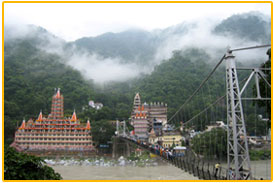 The
holy town of Rishikesh has the
eminence of being the
International capital of Yoga
and meditation. Located in the
foothills of the Himalayas on
the banks of the River Ganges,
Rishikesh is dotted with a
number of ancient temples,
ashrams and world renowned yoga
and meditation centres. Not only
devotees, but travellers from
all parts of the world flock to
the sacred town for a deeper
understanding of meditation. At
the ashrams in Rishikesh,
visitors can attend lectures and
courses offered by celebrated
yoga and meditation experts.
Apart from Hindu shrines, the
town of Rishikesh also invites
adventure lovers from all
around. The
holy town of Rishikesh has the
eminence of being the
International capital of Yoga
and meditation. Located in the
foothills of the Himalayas on
the banks of the River Ganges,
Rishikesh is dotted with a
number of ancient temples,
ashrams and world renowned yoga
and meditation centres. Not only
devotees, but travellers from
all parts of the world flock to
the sacred town for a deeper
understanding of meditation. At
the ashrams in Rishikesh,
visitors can attend lectures and
courses offered by celebrated
yoga and meditation experts.
Apart from Hindu shrines, the
town of Rishikesh also invites
adventure lovers from all
around.
It is also the ideal gateway for
a pilgrim's chardham yatra, that
includes travelling to Yamunotri,
Gangotri, Badrinath and
Kedarnath.
Rishikesh Ganga Aarti :
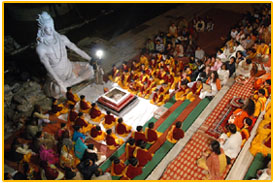 Evening
in Rishikesh are for sitting by
the Ganges and while away your
time. Later in the evening, you
headed towards Parmarth Niketan
Ashram to witness the daily
evening ritual of Ganga Aarti. Evening
in Rishikesh are for sitting by
the Ganges and while away your
time. Later in the evening, you
headed towards Parmarth Niketan
Ashram to witness the daily
evening ritual of Ganga Aarti.
The aarti is a pleasant ritual
of worshipping the Ganga. Around
50-100 people visit the aarti on
any day. You have witnessed
Ganga Aarati in other places
like Haridwar and Varanasi too,
but they are a crowded noisy
ritual with loud screaming
speakers, people troubling you
to make donations or hawkers
trying to sell something highly
overpriced. The Aarti at
Rishikesh is a contrast to it,
held in a small place with a few
people and is a relatively quite
affair. You can sit quietly in a
corner and witness the ritual or
join the crowds singing Bhajans
with them.
The Aarati happens at a very
picturesque place on the banks
of Ganga, in front of a Shiva
statue built on the river. You
see some activity beginning at
the riverbank around 5pm. People
start cleaning up the area, lay
carpets in preparation for the
aarati.
A few people are seen selling
deep or diya - a flower bowl
with a wick lamp to be floated
down the river during the Aarti
after prayers. It starts at
5.30pm, with children studying
Veda, the Bhajan singers and the
performers walking into the ghat
in front of Parmarth Niketan. It
begins with Bhajans and prayers
for 'Gangaji' and Shiva.
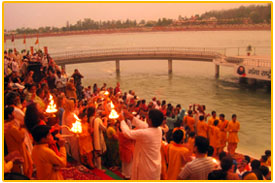 It
is interesting to watch the
children as the ritual
progresses. They look bright and
alive in their saffron robes.
Some of them appear oblivious of
the whole thing and drift into
their own world. A few start a
conversation within themselves.
Some continue singing the
Bhajans with an uninterested
face and a few are motionless,
just sitting there or staring
blankly. There are some who are
completely immersed in the
Bhajans and join everyone with
full enthusiasm, singing and
clapping loudly with the rhythm. It
is interesting to watch the
children as the ritual
progresses. They look bright and
alive in their saffron robes.
Some of them appear oblivious of
the whole thing and drift into
their own world. A few start a
conversation within themselves.
Some continue singing the
Bhajans with an uninterested
face and a few are motionless,
just sitting there or staring
blankly. There are some who are
completely immersed in the
Bhajans and join everyone with
full enthusiasm, singing and
clapping loudly with the rhythm.
As the sun sets and it gets
slightly darker, the Shiva
statue is lighted up and it
looks beautiful. The Aarti
continues with lamps in various
shapes and sizes lighted up, and
passed on from people to people.
The whole place lights up to a
spirited mood with lamps
swinging in the hands of people.
It lasts for an hour and winds
up around 6.30 in the evening
with the notes of "jai jai
radharamana hari bol..."
Places to Visit
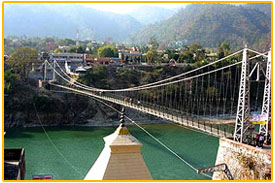 Lakshmanan
Jhula : Lakshmanan
Jhula :
one of the most visited, the
Lakshmana Jhula is a suspended
bridge, extending from one bank
of the Ganges to the other.
The bridge is mythologically
significant because it is where
Lakshman crossed the Ganga
through on jute-rope-made
bridge. Visitors can enjoy some
impressive views of the
Himalayan ranges from upon the
bridge. Today, the Lakshmana
Jhula connects two popular
ashrams - Shivanand Ashram and
Swarg Ashram.
Ashrams
in Rishikesh :
Ashrams are a major crowd-puller
in Rishikesh. These ashrams
offer regular courses and
classes on spiritual disciplines
like yoga and meditation as well
as Ayurveda.
Accommodation facilities are
also available for tourists and
pilgrims arriving at the
ashrams. Popular ashrams in
Rishikesh include Gita Ashram
(set up in the 1950s), Swarg
Ashram (one of the oldest in the
town) and Shivananda Ashram
(which houses the Divine Life
Society, founded by Swami
Shivanand i 1936).
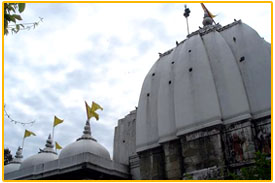 Bharat
Mandir : Bharat
Mandir :
Established back in the 12th
century, the Bharat Temple
happens to be the oldest in
Rishikesh. The temple stands in
dedication to Bharat, the
younger brother of Rama (hero of
the Hindu epic Ramayana).
Though the original temple
structure was destroyed in an
invasion by Temur in 1398, the
temple still preserves a number
of Hindu relics. The inner
sanctum of the Bharat Mandir
enshrines the idol of Lord
Vishnu. The temple stands close
to the Triveni Ghat in
Rishikesh.
Sai
Darbar :
Situated 8 Kms along the Clock
Tower on Rajpur Road, is the Sai
Darbar Temple. This place holds
a high cultural and spiritual
value and is visited by tourists
from across the country and
foreigners as well.
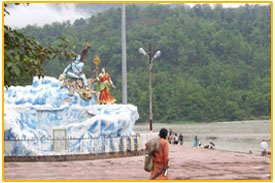 Triveni
Ghat : Triveni
Ghat :
The most popular bathing ghat in
Rishikesh, the Triveni Ghat is
the point where River Ganges
takes a complete right angle
turn. Hindus also believe that
it is here that the three holy
rivers Ganga, Yamuna and
Saraswati converge. Every
morning, scores of pilgrims and
devotees can be seen here taking
a holy dip in the divine waters
of the Ganga. In the evening,
the sight at the ghat is simply
heart stirring. Vedic chants, to
the accompaniment of drums and
bells, can be heard all around
and a spiritual aura surrounds
the whole place. Tiny oil lamps
on bedecked leaf boats floating
on the Ganges add much charm to
the whole atmosphere.
Geeta
Bhawan:
Geeta Bhawan is one of the
oldest temple complexes situated
by the side of Laxman Jhula on
the banks of sacred Ganges in
Rishikesh. Gita Bhavan is
dedicated as a Museum for
puranic and mythological
awareness for the common public.
Building consists of a very
large complex comprising
discourse halls and over 1000
rooms available free of charge
for the stay of devotees. For
the convenience of the devotees,
simple vegetarian food, kitchen
and grocery items and Indian
sweets are available at very
moderate price.
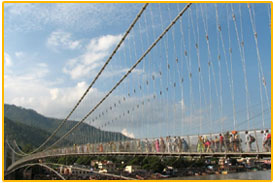 Ram
Jhula : Ram
Jhula :
The place (or the bridge) is
equally popular with devotees
and tourists. It remains
suspended 3 km north of
Rishikesh town. It attracts most
visitors due to the fact that it
lies just close to the popular
ashrams - Geeta Bhawan and Swarg
Ashram. Visitors cannot afford
to miss the enchanting evening
prayer (which lasts for 30
minutes) at the Geeta Bhawan's
ghat. Food lovers can head
straight to the 50-year-old and
the very famous Chotiwala
Restaurant, located in Ram Jhula.
Neelkanth Mahadev:
Thousands of devotees visit
Neelkanth Mahadev every month
throughout the year. It is
situated on the summit of the
mountain across the sacred Ganga
River. According to mythology
this is the place where Lord
Shiva drank the venom produced
during 'Sagar Manthan' which
turned his throat blue and was
thus the place was named as
Neelkanth. Neelkanth and Mahadev
are names of Lord Shiva.
Kuari
Pass Trek
Kuari Pass Trek is one of the
most superb circuits midst of
the amazing Himalayan mountain
ranges, which is a well-liked
adventure activity in Indian
Himalaya, inviting tons of
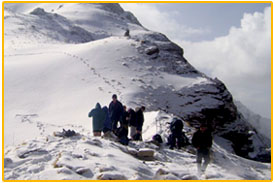 adventure
enthusiasts each year. It
provides trekkers outstanding
sightseeing of flowery green
meadows, broad forests,
fascinating local communities
and astounding landscape of the
eastern part of the Garhwal
Himalayan ranges. adventure
enthusiasts each year. It
provides trekkers outstanding
sightseeing of flowery green
meadows, broad forests,
fascinating local communities
and astounding landscape of the
eastern part of the Garhwal
Himalayan ranges.
The outstanding circuits are
from time to time called the
Lord Curzon trail, named after
the previous invader of India,
Lord Curzon. Throughout ancient
times, he exposed the mountain
ranges, and made the complete
trail from the pass to
Joshimath. From that time on the
trek becomes a well-popular spot
for vacationers.
Trekking is a well-liked
activity for people who love
exciting activity, exploring the
wonders of the Himalayas.
Magnificent sights of Gohna Lake
are one of the most sought after
views in the trek's route.
Anyone who frequents this place
dazzles on the breathtaking
sceneries provided by the trail.
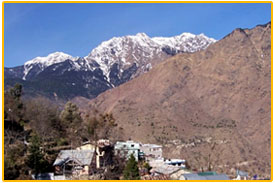 Day
1: Rishikesh/Joshimath drive 8-9
hours overnight Hotel Day
1: Rishikesh/Joshimath drive 8-9
hours overnight Hotel
After an early breakfast drive
to Joshimath (1890mt) via
Devprayag, Rudraparyag,
Karnparyag and Nandparyag, the
most famous confluences of
Garhwal Himalayas. Lunch enroute.
Arrive Joshimath check in hotel,
Later visit to small hill town,
Joshimath is the winter seat of
Lord Badrinath, Meals and over
night hotel.
Day 2:
Joshimath/Auli/ Chitrakantha
(310 Mt) Trek 6-7 hours
overnight Camp
Early in the morning after
breakfast 13 km drive to Auli,
Later start your trek to
Chitrakantha, one can see the
magnificent view of Nanda Devi
peak. Enroute we will cross the
famous Bugyals (meadows) of
Gorson and from here we can see
the entire range of Nanda Devi
sanctuary, along the Rishi
Ganga. Meals and overnight stay
in tents.Early in the morning
after breakfast 13 km drive to
Auli, Later start your trek to
Chitrakantha, one can see the
magnificent view of Nanda Devi
peak. Enroute we will cross the
famous Bugyals (meadows) of
Gorson and from here we can see
the entire range of Nanda Devi
sanctuary, along the Rishi
Ganga. Meals and overnight stay
in tents.
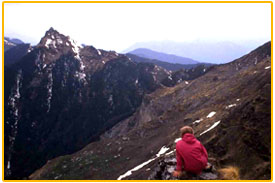 Day
3: Chitrakantha/Kuari Pass/
Dhakwani Trek 5-6 hours
overnight Camp Day
3: Chitrakantha/Kuari Pass/
Dhakwani Trek 5-6 hours
overnight Camp
In the morning after breakfast
we will trek to
Kunwaripass(3850mt). The trek is
its gradual climbing on the
ridge till Kunwaripass with same
view as from Garson. Enjoy the
panorammic view of Great
Himalayan peaks, Later trek down
to Dhakwani (3100mt), Arrive
Dhakwani and camp, Meals and
overnight tents.
Day 4:
Dhakwani/Pana (2650 Mt) TREK 6-7
hours overnight Camp
In the morning after breakfast
trek to Pana. The entire trek
goes through the forest with up
and down way, Enroute we will
find lush green meadows, water
falls, snow clapped mountains
and much more. Arrive Pana and
camp, meals and overnight stay
in tents.
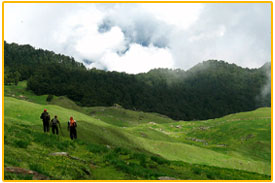 Day
5: Pane/Seemkharak (2550 Mt)
Trek 5-6 hours overnight Camp Day
5: Pane/Seemkharak (2550 Mt)
Trek 5-6 hours overnight Camp
In the morning after breakfast
we will trek to seemkhark via
Jhinjhi village, Today the trek
is decending first and then
assending through the village,
Arrive Seemkharak and camp,
Meals and overnight camp.
Day 6:
Seemkharak/ Ghuni (1700 Mt) Trek
4-5 hours overnight Camp
Morning after breakfast 2 and ˝
hours trek up to
Chachnivinayakpass(3400mt) Later
trek down to Ghuni village on
the way enjoy the view of Ghat
valley, Arrive Ghunni and camp,
Meals and overnight camp.
Day 7:
Ghuni/Ghat TRrek 5-6 Trek 4-5
hours overnight Camp
After breakfast trek down to
Ghat and camp, today camp is on
road head one can bath in river
Nandakini or relax. Meals and
overnioght tents.
Day 8:
Ghat/Rishikesh drive 7-8 hours
After breakfast drive to
Rishikesh, Lunch enroute, Arrive
Rishikesh and tour terminate
upon arrival at Rishikesh.
Chandrashilla Trek
Chandrashila Trek is one of the
popular trek that can be
undertaken round the year, in
Garhwal Himalayas except during
heavy snowing months of December
&
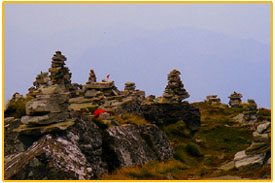 January.Chandrashila
summit is a rock face above the
temple of Tungnath, the highest
of all the temples in the
Himalayas. It is a short but
rigorous hike beyond the temple.
The Chandrashila summit affords
the most beautiful view of the
Nanda Devi, Trishul, Kedar Peak
and Chaukhamba peaks.Chopta is
one of the most beautiful and
picturesque spots in the whole
Garhwal. January.Chandrashila
summit is a rock face above the
temple of Tungnath, the highest
of all the temples in the
Himalayas. It is a short but
rigorous hike beyond the temple.
The Chandrashila summit affords
the most beautiful view of the
Nanda Devi, Trishul, Kedar Peak
and Chaukhamba peaks.Chopta is
one of the most beautiful and
picturesque spots in the whole
Garhwal.
The breathtaking view of the
Himalayas is treat for the eyes
as well as soul. Chopta is
situated on the Gopeshwar -
Ukhimath road at a distance of
about 40 Kms. from Gopeshwar
Chopta is 2900 mts high.
Deoriatal Lake has captivating
surroundings with forest all
around. The mighty Chaukhamba
Peak & Neelkanth peaks are
reflected in the pristine waters
of this lake.
Day 01:
Rishikesh - Ukhimath (200
kms/7-8 hrs)
Arrival at Rishikesh by early in
the morning at 04:00 hrs. Upon
arrival at Rishikesh transfer to
Ukhimath via Devprayag
(Confluence of Alaknanda &
Bhagirathi, from Devprayag the
Holy river Ganges started),
Rudraprayag (Confluence of
Alaknanda & Mandakini River).
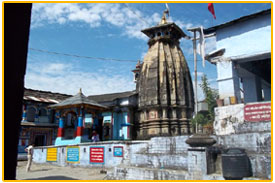 Breakfast
and lunch enroute. Arrival at
Ukhimath by evening. Check into
TRH. Dinner and overnight stay. Breakfast
and lunch enroute. Arrival at
Ukhimath by evening. Check into
TRH. Dinner and overnight stay.
Ukhimath (1370 mts/4500 ft) is
on the other side of the
Mandakini River Valley from
Guptkashi a relatively short
steep walk by foot, or a much
longer way by road. Ukhimath is
the winter seat of Kedarnath, as
well as the winter home of the
priest who presides over his
worship. After the Kedarnath
temple closes for the winter, a
movable image of Kedarnath is
brought in procession to
Ukhimath, where it resides until
the Kedarnath temple reopens in
late April or early May.
This picture shows the outer
gateway to the temple complex,
which is not only brightly
painted and decorated, but two
full stories tall (the wall also
serves as the back wall of
buildings inside). The stones
piled at lower left were for
some sort of construction
project, which was in full swing
when I visited (since summer is
the "slow" season ritually
speaking, it made sense for the
place to
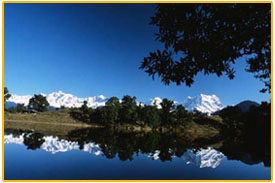 be
torn up them. And the nearby
buildings are clearly
residential, since a young girl
is visible at upper right. be
torn up them. And the nearby
buildings are clearly
residential, since a young girl
is visible at upper right.
Day 02:
Ukhimath – Deoriatal (2438
mts/7998 ft)
In the morning you can see snow
clapped Himalayan ranges. After
breakfast start your trek to
Deoriatal through dense forest
of Rhodendron and lots of wild
flowers and ferns. The trek will
take 3- 4 hrs to reach
Deoriatal. Upon arrival at
Deoriatal set out the tents for
overnight stay.
Day 03:
Deoriatal – Sari - Chopta
In the morning trek down to Sari
village (3 kms) and from here
drive to Chopta through dense
forest and meadows. Its 30 kms
drive from Sari Village. Upon
arrival at Chopta set out your
tents for overnight stay. In the
evening explore the magnificent
view of the Himalayas.
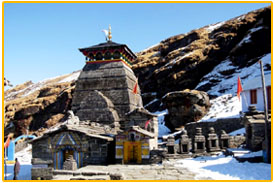 Day
04: Chopta –Tungnath (3680
ft/12070 ft) – Chandrasila (4090
mts/13415 ft) - Chopta Day
04: Chopta –Tungnath (3680
ft/12070 ft) – Chandrasila (4090
mts/13415 ft) - Chopta
After an early breakfast trek to
Tungnath with packed lunch.
Tungnath is situated at the
height of 3680 mts from the sea
level the highest in India. The
trek is three kms upward.
Enroute you will find lush green
meadows and you can see the
entire range of snow clapped
Himalayas. Upon arrival at
Tungnath Temple and visit the
temple. After relax one further
one kms trek to Chandrasila
peak. Later trek back to Chopta
for dinner and overnight stay.
Day 05:
Chopta – Rishikesh
After an early breakfast drive
to Rishikesh. Breakfast & Lunch
enroute.
Valley of Flowers Trek
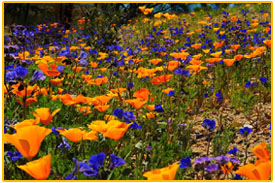 Valley
of Flower : Valley
of Flower :
The beautiful valley situated at
an altitude of 3300 to 3650 mts
is the ‘paradise’ of nature
lovers. Starting from about 6
kms from Bhinduar village it
covers an area of about 87
square kms. The valley is
exceptionally rich of the
flowers wealth and has the
largest collection of wild
flowers species. The river
Pushwati flows through the
verdant valley. The valley
blooms with exotic. Flower from
June, July till September.
There are about 520 species of
flowering plants and the area
was declared as a National Park
in 1982. The animal like
Himalayan black beers, musk
deers, brown beers, Bharal and
rich variety of birds and butter
flies are found in this national
Park.
Day 01:
Rishikesh - Joshimath (245
kms/8-9 hrs)
After an early breakfast drive
to Joshimath via Devprayag. On
the way visit Dev prayag where
Bhagirathi and Alaknanda rivers
meet.
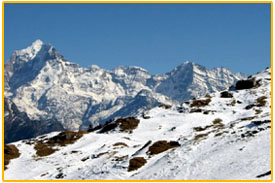 From
here the holy river Ganges
started. Arrival at Joshimath by
evening, check into the hotel.
Dinner & overnight stay. From
here the holy river Ganges
started. Arrival at Joshimath by
evening, check into the hotel.
Dinner & overnight stay.
Joshimath :
The religious centre,
established by Adi
Shankaracharya, which he called
Jyotirmath, later came to be
known as Joshimath. Among the
sites of interest are the
temples of Nav Durga and
Narsingh. Apart from its obvious
religious importance, Joshimath
is known for its scenic beauty.
Day 02:
Joshimath – Govindghat (22 kms/1
hrs) – Ghangaria (14 kms/3-4
hrs)
After an early breakfast drive
to Govindghat. Which is the
starting point of the trek. From
Govindghat there is a gradual
ascent along a well maintained
pilgrim trail to Ghangaria. Upon
arrival at Ghangria check into
hotel. Explore the surroundings
in the evening. Dinner and
overnight stay at the hotel.
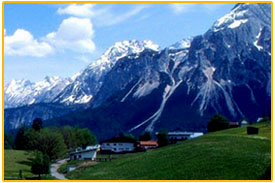 Day
03: Ghangaria - Valley Of
Flowers – Ghangria (5 kms one
side/4-5 hrs) Day
03: Ghangaria - Valley Of
Flowers – Ghangria (5 kms one
side/4-5 hrs)
After breakfast trek to Valley
Of Flowers (3858 m) from
Ghangaria. The valley is an
enchanting sight with an
impressive array of rare
wildflowers like Geranium, Marsh
marigold, Prinula, Potentilla,
Geum, Asters, Lilium, Ranunculus,
Corydalis, Inula, Braham kamal,
Campanula, Pedicularis, Arisaema,
Morina, Impatiens, Bistorta,
Ligularia, Anaphalis,
Saxifrages, Sibbaldia, Thermo-
psis, Trollius, Codonopsis,
Dactylorhiza, Cypripedium, Str-
awberry, Epilobium,
Rhododendrons and numerous
others. Most of the flowers have
medicinal values too. The valley
is 10 kms long, 2 kms wide, and
is divided by the Pushpawati
stream, into which several tiny
streams and waterfalls merge.
After enjoying the beauty of
valley trek back to Ghangaria.
Dinner & overnight stay at the
hotel.
Day 04:
Ghangaria – Hemkund Sahib -
Ghangaria (6 kms one side/ 3-4
hrs)
After breakfast trek to Hemkund
Sahib (4329 m) from Ghangaria.
This is quite a steep climb. In
the Sikh holy book, The Granth
Sahib, the Sikh Guru Gobind
Singh recounts that in
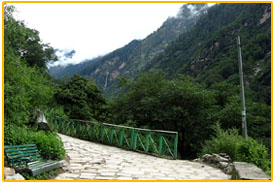 a
previous life, he meditated on
the shores of a lake surrounded
by seven snowcapped mountains
now recognized by Hemkund. Late
afternoon trek back to Ghangaria.
Dinner & overnight stay at the
hotel. a
previous life, he meditated on
the shores of a lake surrounded
by seven snowcapped mountains
now recognized by Hemkund. Late
afternoon trek back to Ghangaria.
Dinner & overnight stay at the
hotel.
Day 05:
Ghangaria – Govind Ghat -
Joshimath
After breakfast trek down to
reach Govind Ghat and from here
drive to Joshimath. Upon arrival
at Joshimath check into the
hotel. Rest of the day is free
to explore the area. One can
also visit Auli in the evening.
Dinner and over night stay at
the hotel..
Day 06:
Joshimath - Rishikesh
Early morning drive to Rishikesh
with packed breakfast. On the
way visit Rudraprayag where
river Mandakini and Alaknanda.
Har Ki
Dun Trek
Har-ki-Dun
:
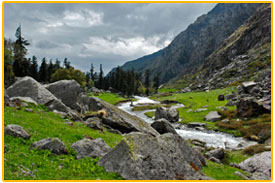 Har-ki-Dun, situated at an
elevation of 3566 meters is
surrounded by glittering peaks
and dense forests. The forests
are rich in wild life and are a
veritable paradise for
bird-watchers and nature lovers.
This is good trek for all age
groups and the valley is full of
flora and fauna. One can spend
time with herbs & shrubs for
medicinal purpose.Also
photography too has great area
to snaps for variety of birds &
nature. Har-ki-Dun, situated at an
elevation of 3566 meters is
surrounded by glittering peaks
and dense forests. The forests
are rich in wild life and are a
veritable paradise for
bird-watchers and nature lovers.
This is good trek for all age
groups and the valley is full of
flora and fauna. One can spend
time with herbs & shrubs for
medicinal purpose.Also
photography too has great area
to snaps for variety of birds &
nature.
This is a holly place. Also it
is a base of Swargarohini ht.
21000 ft. In our old granth
(books) it is mentioned that
Pandav went to Swarga (Heaven)
through this mountain. This is a
place where you can find Trees
of Bhojpatra flower Bramhakamal.
Swargarohini and Jaundar Glacier
is at south-east of Har-ki-dun.
Towards west you can see Bandar
PunchDuryodhan is a God of few
community here, you can find
temple of Duryodhan. People
survive on farming Rice, Rajma,
and Charas. They use wood of
Deodar tree for their house. You
can find many people using Hukka
for smoking.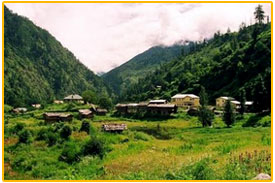 One can smell of
pine while having Hukka. Also
because of popularity of this
area for trekking Portrays is
another way to earn for locals
here. They generally work under
the Kedar. One can smell of
pine while having Hukka. Also
because of popularity of this
area for trekking Portrays is
another way to earn for locals
here. They generally work under
the Kedar.
Day 01:
Rishikesh – Taluka (1900 m/6232
ft) (215 kms/ 7-8 hrs)
After breakfast drive to Taluka
by Toyota Qualis, a small hamlet
nestled in the laps of nature
via Mussoorie, Kempty falls,
Purola and Mori. This is
starting point of our trek.
Overnight in tents/ tourist rest
house
Day 02:
Taluka – Osla (2560 m / 8400 ft)
(13 kms/6-7 hrs)
The day starts with the gentle
trail towards Osla. Today’s trek
is through beautiful forests of
Chestnut, Walnut and Willows. A
gradual ascent brings us to the
picturesque Osla village along
the swift rivulet. On arrival
set campsite for overnight stay
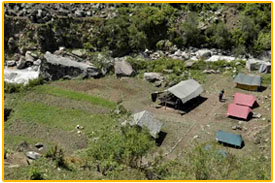 Day 03:
Osla – Har – Ki Dun (3566 m /
11700 ft) (12 kms/6-7 hrs) Day 03:
Osla – Har – Ki Dun (3566 m /
11700 ft) (12 kms/6-7 hrs)
Morning after breakfast trek to
Har Ki Dun. Initially the trek
goes past some fields of beans &
rice and also some isolated
villages, where the life style
is same as old, and the
untouched one. The dress worn by
the people is traditional. Their
cheerful ness and innocence
combined with their simple way
of life make them very
appealing. A common scene in the
evenings is that of ruddy
cheeked village belles returning
home, carrying
on their backs huge loads of
pine needles & cones to be used
as fuel. The trail steadily
ascends the side of the ridge
across the river and then veers
left to the Har Ki Dun valley.
Dense forests at this part give
way to the meadows that are
scattered with flowers and
flowering herbs. Dinner and o
Overnight stay in tents.
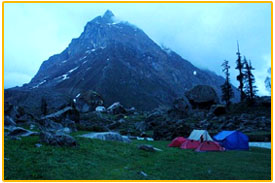 Day 04:
Har-Ki-Dun Day 04:
Har-Ki-Dun
The day is for rest/
acclimatization /exploration. On
this day everyone does his own
thing. One can go on an
exploratory trek in the valley,
capture some magnificent views
on the camera, or just chill at
the campsite. Overnight in
tents.
Day 05:
Har Ki Dun – Osla
Morning after breakfast trek
back to Osla with pack lunch.
Dinner and overnight stay in
tents.
Day 06:
Osla – Taluka (13 kms/3-4 hrs) –
Rishikesh
After early breakfast trek for
about 3-4 hours to reach Taluka
and from here drive back to
Dehradun. Upon arrival at
Dehradun transfer to Delhi. |

